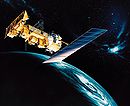- NOAA-18
-
NOAA-18 is a weather forecasting satellite run by NOAA. NOAA-N (18) was launched on May 20, 2005,[1] into a sun-synchronous orbit at an altitude of 854 km above the Earth, with an orbital period of 102 minutes.[2] It hosts the AMSU-A, MHS, AVHRR and High Resolution Infrared Radiation Sounder (HIRS) instruments, as well as the SBUV/2 ozone-monitoring instrument.[3] It is the first NOAA POES satellite to use MHS in place of AMSU-B.
APT transmission frequency is 137.9125 MHz (NOAA-18 changed frequencies with NOAA-19 on June 23, 2009)[4]
References
- ^ http://www.osd.noaa.gov/POES/NOAA-N_Prime_Booklet_12-16-08.pdf
- ^ http://www.oso.noaa.gov/poesstatus/spacecraftStatusSummary.asp?spacecraft=18
- ^ http://www.osd.noaa.gov/download/noaa_n_booklet.pdf
- ^ http://www.wxtoimg.com/
TIROS satellites TIROS 
TOS ITOS TIROS-N Adv. TIROS-N ← 2004 · Orbital launches in 2005 · 2006 → Deep Impact | Kosmos 2414 · Universitetsky-Tatyana | AMC-12 | USA-181 | XTAR-EUR · Maqsat-B2 (Sloshsat-FLEVO) | Himawari 6 | Progress M-52 (TNS-0) | XM-3 | Inmarsat-4 F1 | Ekspress AM-2 | USA-165 | Apstar VI | Soyuz TMA-6 | DART | Spaceway 1 | USA-182 | Cartosat-1 · HAMSAT | NOAA-18 | DirecTV-8 | Foton-M2 | Progress M-53 | Molniya-3K #12 | Cosmos 1 | Intelsat Americas 8 | Ekspress AM-3 | Shijian 7 | Suzaku | STS-114 (Raffaello MPLM) | FSW-21 | Thaicom-4 | MRO | Kirari · Reimei | Monitor-E | FSW-22 | Kosmos 2415 | Progress M-54 (RadioSkaf) | Anik F1R | USA-183 | Soyuz TMA-7 | CryoSat | Shenzhou 6 | Syracuse 3A · Galaxy 15 | USA-186 | Beijing-1 · TopSat · Sina-1 · SSETI Express (CubeSat XI-V · UWE-1 · nCUBE-2) · Mozhaets-5 · Rubin-5 | Inmarsat-4 F2 | Venus Express | Spaceway-2 · Telkom-2 | Gonets-D1M #13 · Kosmos 2416 | Meteosat 9 · INSAT-4A | Kosmos 2417 · Kosmos 2418 · Kosmos 2419 | GIOVE-A | AMC-23Payloads are separated by bullets ( · ), launches by pipes ( | ). Manned flights are indicated in bold text. Uncatalogued launch failures are listed in italics. Payloads deployed from other spacecraft are denoted in brackets. Categories:- Weather satellites
- 2005 in spaceflight
- United States spacecraft stubs
- Atmospheric science stubs
Wikimedia Foundation. 2010.
